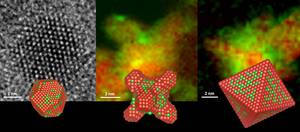The Riddle of Platonic Catalysts is Solved
 |
19 December 2014
The growth mechanism of platinum-nickel octahedron particles is discovered. The work of UniCat-Professor Peter Strasser in “Science” magazine
A research team led by Peter Strasser (Research Fields D3 and E3) was able to identify the chemical growth mechanism of platinum-nickel octahedron particles. The researchers deliver fundamentally new scientific evidence, which will help in the future to improve the role of many other materials as catalyst.
Many industrial processes in the chemical industry make use of spherical metal particles as catalyst for their reaction accelerating effect. These particles measure few nanometers in diameter which equals the ten thousandth of the diameter of the human hair.
Based on their spherical shape, however, the geometric arrangement of their metal atoms on the surface varies greatly and every single geometric arrangement shows a highly different catalytic effect. Therefore, the catalytic effect is generally not perfect. It would be better to prepare metal particles in the shape of Platonic solids such as the tetrahedron, octahedron or cube because these mathematical structures show on their surface by nature an atom arrangement that is typical for it. If the catalyst activities of these atomic geometries are known, then it is possible to predict whether a metal particle in the form of a cube or purely in the shape of an octahedron would be best for the chemical reaction. This has already been well researched for monometallic particles comprised of one type of atom.
However, it is much more difficult to produce Platonic catalysts consisting of two different types of atoms. Thus far, the atomic processes of formation and growth of such Platonic bimetallic catalysts have been unknown. The assumption was that bimetallic octahedra are created in their form and then just grow larger. This was proven to be false.
Based on a bimetallic metal particle catalyst in the shape of octahedra, consisting of platinum (Pt) and nickel (Ni) atoms, the team led by TU Professor Dr. Peter Strasser was able to identify the chemical growth mechanisms of such platinum-nickel octahedra particles. Therefore, the researchers provide fundamentally new scientific evidence which will allow improving many other materials in their function as catalysts.
There is large interest in platinum-nickel particles in the form of octahedra because they are seen as the most effective metal catalysts for fuel cells and this would require two to three times less platinum compared to spherical platinum-nickel catalysts.
In cooperation with the Ernst-Ruska-Center for electron microscopy of the Jülich research center and the RWTH Aachen, researchers discovered that octahedra are first created as spherical shape and then a unique self-organizing mechanism begins, which creates step-by-step the eight uniform planes of an octahedron. First, a regular six-arm geometric structure, the “hexapod”, forms. It consists predominantly of platinum atoms. The nickel atoms attach to them preferably in the hallow spaces between these six arms, finally to complement the form of the octahedron. In the end, the nickel and platinum atoms are highly anisotropic, i.e. not uniformly distributed in the catalyst particle and on its surface. The riddle of this atom-specific anisotropy is finally solved.
For the original publication, go to the following page:
http://www.sciencemag.org/lookup/doi/10.1126/science.1261212
For further information, please contact:
Prof. Dr. Peter Strasser
TU Berlin
Institute of Chemistry
Chair of Electrocatalysis - Electrochemistry - Materials
Tel.: 030/314- 22261
E-Mail: pstrasser(at)tu-berlin.de
